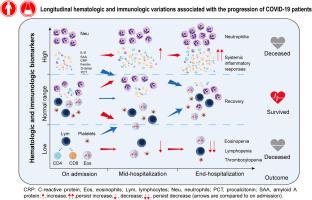Journal of Allergy and Clinical Immunology ( IF 11.4 ) Pub Date : 2020-05-11 , DOI: 10.1016/j.jaci.2020.05.003 Ruchong Chen 1 , Ling Sang 2 , Mei Jiang 2 , Zhaowei Yang 1 , Nan Jia 1 , Wanyi Fu 1 , Jiaxing Xie 1 , Weijie Guan 2 , Wenhua Liang 2 , Zhengyi Ni 3 , Yu Hu 4 , Lei Liu 5 , Hong Shan 6 , Chunliang Lei 7 , Yixiang Peng 8 , Li Wei 9 , Yong Liu 10 , Yahua Hu 11 , Peng Peng 12 , Jianming Wang 13 , Jiyang Liu 14 , Zhong Chen 15 , Gang Li 16 , Zhijian Zheng 17 , Shaoqin Qiu 18 , Jie Luo 19 , Changjiang Ye 20 , Shaoyong Zhu 21 , Jinping Zheng 2 , Nuofu Zhang 2 , Yimin Li 2 , Jianxing He 2 , Jing Li 1 , Shiyue Li 2 , Nanshan Zhong 2 ,

|
Background
Crucial roles of hematologic and immunologic responses in progression of coronavirus disease 2019 (COVID-19) remain largely unclear.
Objective
We sought to address the dynamic changes in hematologic and immunologic biomarkers and their associations with severity and outcomes of COVID-19.
Methods
A retrospective study including 548 patients with COVID-19 with clarified outcome (discharged or deceased) from a national cohort in China was performed. Cross-sectional and longitudinal variations were compared and the associations with different severity and outcomes were analyzed.
Results
On admission, the counts of lymphocytes, T-cell subsets, eosinophils, and platelets decreased markedly, especially in severe/critical and fatal patients. Increased neutrophil count and neutrophils-to-lymphocytes ratio were predominant in severe/critical cases or nonsurvivors. During hospitalization, eosinophils, lymphocytes, and platelets showed an increasing trend in survivors, but maintained lower levels or dropped significantly afterwards in nonsurvivors. Nonsurvivors kept a high level or showed an upward trend for neutrophils, IL-6, procalcitonin, D-dimer, amyloid A protein, and C-reactive protein, which were kept stable or showed a downward trend in survivors. Positive correlation between CD8+ T-cell and lymphocytes count was found in survivors but not in nonsurvivors. A multivariate Cox regression model suggested that restored levels of lymphocytes, eosinophils, and platelets could serve as predictors for recovery, whereas progressive increases in neutrophils, basophils, and IL-6 were associated with fatal outcome.
Conclusions
Hematologic and immunologic impairment showed a significantly different profile between survivors and nonsurvivors in patients with COVID-19 with different severity. The longitudinal variations in these biomarkers could serve to predict recovery or fatal outcome.











































 京公网安备 11010802027423号
京公网安备 11010802027423号